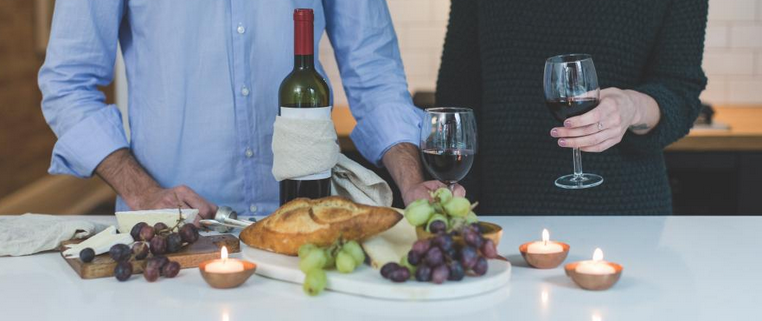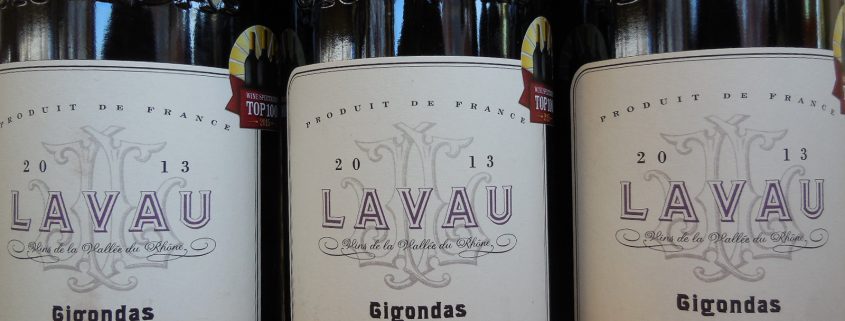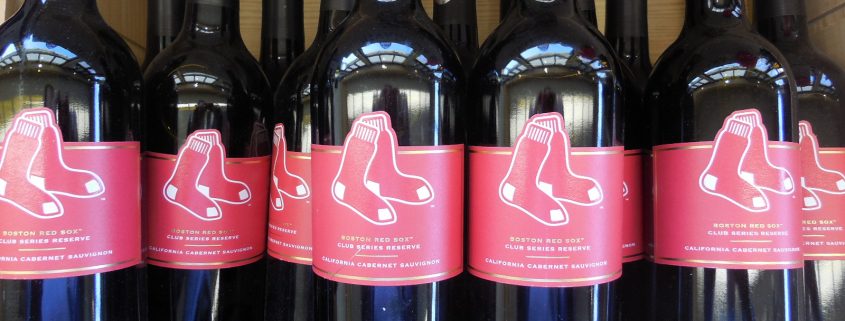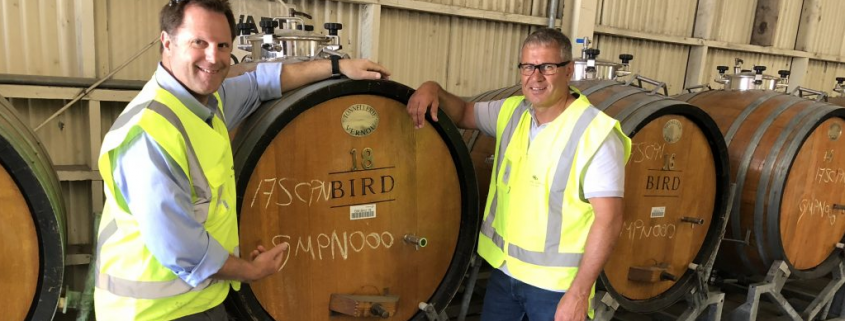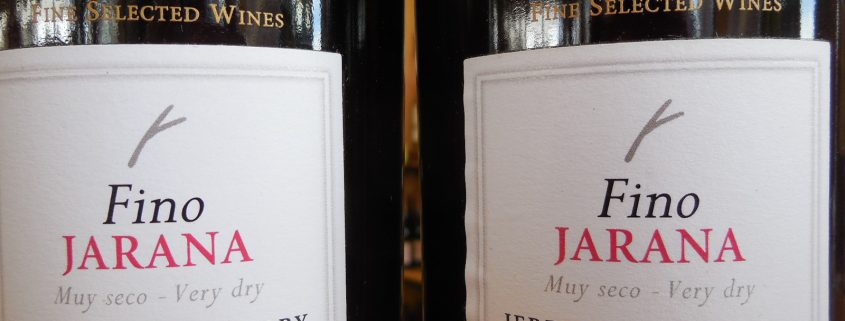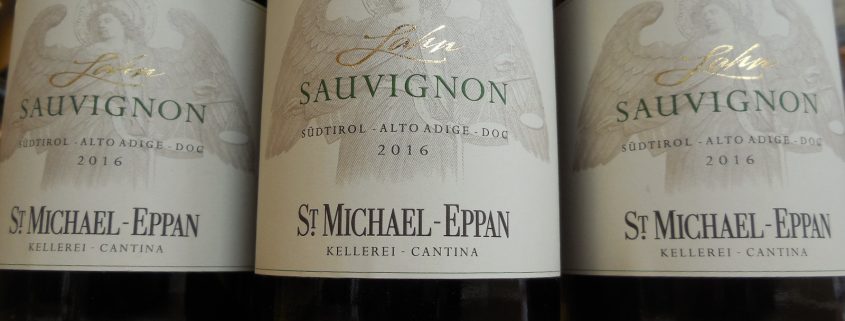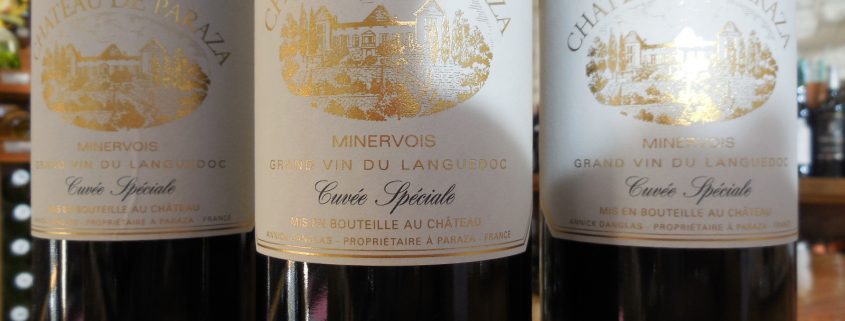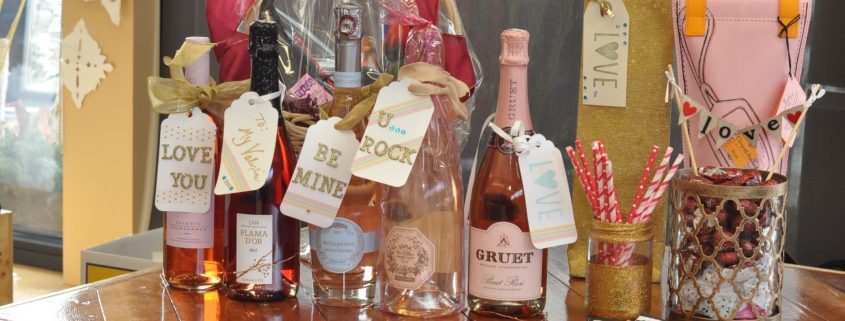- White wines tend to show more oak because the wine itself tends to have more delicate flavors and fewer tannins. The oak itself has tannins that bind with the proteins in the wine, so whites do not become more tannic with oak fermentation or aging.
- Red wines on the other hand, already have tannins that have bound with the proteins in the wine. That means that non-neutral oak generally imparts more tannins to red wines than they have naturally. So, in addition to the vanilla / caramel / butterscotch types of flavors in American oak and the more coconut / hazelnut / smoky flavors in French oak, red wines tend to become more structured in oak barrels.
Posts
When I began studying wine several years ago, I really just wanted to know the difference between a Rhone and a Burgundy, a Napa Cabernet and a Bordeaux. I did not have any grand ambitions. However, as I progressed through the classes, I realized that wine brings so many subjects together – you have to pore over detailed maps to memorize appellations, you have to know the different character imparted by schist or slate or loam or limestone, you have to study how many hours of sun each zone averages to know which grapes are likely to ripen well or over cook in which areas. You have to smell your way through the world – what is the difference between black berry and black currant? What does acacia or hawthorn smell like? is there a difference between lemon, lime and grapefruit smells? Or apples, pears and quince? You also have to study the various ways that wines are made – when are they harvested and by machine or hand? How are they crushed? How is the juice handled before fermentation? What temperature do you ferment at and which strains of yeast do you use? Then there are complicated processes for filtering, fining, additional malolactic fermentation, blending, aging, bottling…
It is astounding how complicated the process is and how much of a bargain wine is at almost any price that we pay these days.
Wine is a second career for me – in the my previous life, I worked in international development and traveled the world. I have been to Mali and Malawi, Albania and Macedonia, India and Indonesia, Nepal and Mongolia. After having children, this sort of travel became impossible and it took me years to find something that was as absorbing and challenging, not to mention something that would give me enough of a reason to take time off from spending all my time with my children.
Who knew wine could be that thing? The more I learn about the wine world, the more I realize there are depths and nuances that I would never have guessed. Something relatively new to me has been the world of Wine-as-fundraising. The wonderful thing for me is that it brings my previous life – working with the poor and vulnerable – together with my new life – learning and teaching about wine. Therefore, the wine I am discussing and we will taste in the shop this week is a wine for a cause.
Thanks for reading, Seema
As opening day for the Red Sox approaches, I can tell the fans are getting excited. The problem is and I have to be honest, I am not a baseball fan. I know people LOVE the Red Sox and I appreciate that – I am a fan of wines and would totally fan-girl over some famous winemakers, give critical commentary on their raw materials, their decisions for how to make wines, how to label them, when to release them. And most philosophical, I think people find real depth when thinking of and speaking about baseball – similar to the Truth that is said to lurk in every bottle of wine. The link between the two seems inevitable.

Photo by: CBS Boston
Being a complete novice though at baseball, I began researching this game that so absorbs and thrills fans. The wisdom among its famous is quite real. For example, some guy named Bob Feller said, “Everyday is a new opportunity. You can build on yesterday’s success or put its failures behind you and start over. That’s the way life is, with a new game everyday and that is the way baseball is.” Those truly are words to live by. I also loved Tommy LaSorda saying, “There are three types of baseball players, those who make things happen, those who watch things happen and those who wonder what happened.” Again, this is a very profound life lesson.
But perhaps the person most credited with folksy wisdom in baseball appears to be Yogi Berra. And these seem to be his best quotes:
• “When you get to a fork in the road, take it.”
• “It gets late early around here.”
• “A nickel ain’t worth a dime anymore.”
• “The future ain’t what it used to be.”
• “Ninety percent of this game is half mental.”
• “I really didn’t say everything I said.”
• “You can observe a lot just by watching.”
• “Half the lies they tell about me aren’t true.”
• “If you don’t know where you’re going, you might end up someplace else.”
• “Love is the most important thing in the world, but baseball is pretty good too.”
But to go with all this wisdom, one needs the right wine. What better choice than the Red Sox Club Series Cabernet Sauvignon? Wine consumption grew 40% between 2000 and 2013 and baseball club series labels are sold in many stadiums these days – meaning people are drinking wine at baseball games. Beer is losing its supremacy. This wine is bold and structured, the perfect wine to go with meats off the grill – burgers, ribs and sausages. As a Cabernet Sauvignon, it is not as heavy as some others making it more approachable in the summer heat. But perfect for those “I’m-expecting-it-to-be-warm-but-it’s-still-cold” spring days. It has all the black currant you expect from a Cab but also some subtle hints of chocolate and tobacco, with a nice fruity finish. It is the perfect gift for a baseball fan on opening day!
Enjoy, Seema
I love it when I speak with people and they have strong opinions on wine. Sometimes the opinions are wrong (ahem), but nonetheless, it makes for a lively exchange. For years now, Pinot Noir has had a certain cache, it is the wine grape that has been made into some of the most legendary cuvees of Burgundy, the wellspring of ethereal, elusive, coveted and as a result, unimaginably expensive wines. But in the past few decades, it’s magic has been captured and vinified in the new world. There are purists who would recoil from the idea that one would drink Pinot Noir from anywhere but the golden slopes of Burgundy, but (ahem), they would be wrong.
It turns out that there are valleys in California and Oregon that make just beautiful, scented, delicate, poignant Pinot Noirs. And more recently, the art of Pinot Noir has come to New Zealand.
So what is it about Pinot Noir that is so magical and mysterious? Why do people wax poetic about it? The first thing is that it is a notoriously difficult grape to grow. As the Oxford Companion to Wine states, “Pinot Noir demands more of both the vine-grower and the winemaker…It is a tribute to the unparalleled level of physical excitement generated by tasting one of Burgundy’s better reds that such a high proportion of the world’s most ambitious wine producers want to try their hand with this capricious and extremely variable vine.”
Steve Bird is one such intrepid winemaker. He has dedicated his life to winemaking, coming to it as a high-schooler working at the local winery, studying it in college and then working in wineries his entire life. And his skill is well rewarded in his signature wine, the 2013 Bird Big Barrel Pinot Noir from the Marlborough wine region of the south island of New Zealand.
This wine has some magic in it. When you pour it, it has this amazing gem-like ruby brightness with hints of orange, which indicate it is 5 years old and ready for drinking. Then you smell it. The first impression is of cherry with a light herbal note – maybe mint? But patience is required. This wine has been sitting in this bottle for 5 years now. Swirl it some more – let is open up and relax a bit. Then take another deep breath of it. Now you start of find that elusive quality. It is now full of cherries, a hint of strawberry, some roses and violets and wonderful baking spices, some cloves, some licorice. And yet it remains delicate, there is nothing overt in this wine. It is coy and draws you in. On the palate it is fruity and mouthwatering with just the right amount of silky tannins to make it linger on the finish, again just the right amount.
And voila, one sees that Pinot Noir is indeed able to thrive and prosper outside Burgundy. There are many ways it can express itself. It can put forward its floral character, it can put forward its herbal character; it can be fruity but it can also be savory. But when it is well made, it is always wonderful.
Cheers, Seema (Our local wine expert)
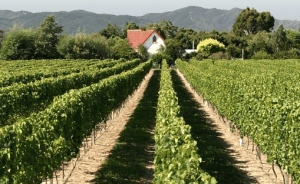
Steve Bird Winery
We have all read the novels where a British matriarch insists on the family dressing formally for dinner and beginning the evening with a round of sherry. Before I ever tried sherry, I always pictured it as a very sophisticated tipple that only the most refined people can enjoy. Then, in my youth, I was introduced to cream sherry, a sweet syrupy concoction that seemed likely to induce a headache when followed by wine at dinner.
It has only been in recent years that (here in the US), the entire range of sherry, from bone dry to sweet, has emerged from the dusty drawing rooms of the china tea set crowd to shine as an aperitif, but also as a wine that can be paired with food and mixed into cocktails. It is a very versatile wine that while making one feel quite sophisticated and international, can still be enjoyed just for itself.
There are several types of sherry one can choose. The lightest and driest style is “Fino” from Jerez or sometimes, Xerez in Spain. On the open, it has a nutty flavor – is it almonds? pecans? and perhaps a bit of salty creaminess? Then one gets a better sense of how it is made – in humid cellars with a mild mushroom note. Then as one continues to contemplate what this is doing to your palate – you get an amazing, yeasty breadlike flavor all over that makes you want to take that next sip and experience it all over again.
Sherry is quintessentially a winemaker’s wine. It is made from the Palomino Fino grape in the town of Jerez de la Frontera in Spain. The British, reluctant to pronounce “jerez” simply called it Sherry. The Palomino grape can withstand drought well – a boon in the arid land of southern Spain – and “produces a reliable crop of slightly low acid, low sugar grapes whose wine may oxidize easily – in short, perfect raw material for sherry.” (JancisRobinson.com) Because it oxidizes so easily, fino sherry is produced in humid, hot cellars that are an ideal breeding ground for a type of mold called “flor.” The flor creates a crust over the wine that imparts a wonderful, cheesy flavor while also protecting it from oxygen by creating a largely impermeable barrier over the liquid (if this barrier of flor is intentionally broken to create a more oxidized style, it is called “oloroso;” if it is unintentionally broken and then further aged, it is called “amontillado”).
One of the coolest aspects of making sherry is the way it is aged and blended. The youngest wines are used to top up the newest barrels of what is known as the solera. It is system by which the wines can be “fractionally blended,” meaning that some wine is new, some is old and these are blended in parts over the course of several years to create a wine of great consistency and relatively high average age. The closest analogy is an escalator. The young wine goes into the barrels on the top level, but only makes up about 50% of that barrel. After a year or two, 50% of this wine is moved to the next level for further aging while 50% of the second level wine is moved to the third level and so on. Usually, there are about 5 to 8 levels on the escalator and each level has a higher and higher average age. Some part of the wine in the last level will still be the very original wine you started with – whether that is 30 years or 50 years old. It is like an extended family tree, with all the character and ructions of each vintage smoothed out to create a unique flavor profile.
Unfortunately, it is wine to be drunk in small quantities or blended into cocktails (see below for two fabulous recipes!). We have enjoyed sherry as an aperitif with marcona almonds, fried calamari and avocado & shrimp salad. But anything salty like olives, any seafood such as oysters, clams, mushrooms caps stuffed with crabmeat or mussels in white wine sauce and most anything fried, like corn fritters would pair beautifully with Fino.
Sherry Cocktail Recipes To Try:
The Sherry App:
1 1/2 ounces Aperol
3/4 ounce fino Sherry
1 ounce fresh grapefruit juice
1/2 ounce fresh lemon juice
1/4 ounce honey simple syrup
Directions: Combine in shaker with ice, shake and strain
The Rye Witch:
1 1/2 cups Kentucky rye whiskey
3 tablespoons Strega (herbal liqueur)
3 tablespoons Fino Sherry
2 tablespoons simple syrup
12 dashes orange bitters
12 orange twists
Directions:
- Combine first 5 ingredients in a large pitcher. Add ice; stir for 15-20 seconds. Strain the mixture into 6 chilled coupe glasses.
- Pinch an orange twist over each drink, then rub around rims of glasses to release oils from peel; discard peel.
Garnish each with a fresh twist.
The angel on the label of this wine says it all – it is heavenly. In more ways than one. Not only is it absolutely, mouth-wateringly delicious, it is grown and made close to the clouds. Alto Adige, Italy or more primly in Austria, Sudtirol, is a land of soaring mountains and lush green valleys divided by the Adige and Isarco rivers.
This is a rugged landscape that includes breathtaking vistas of little fairytale villages and dramatic snowy peaks that reach over 10,000 feet. How do they grow vines in this amazing terrain that can also be cold and forbidding? The answer is very carefully! On small plots of land, lovingly tended by hundreds of farmers. St. Michael-Eppan is a cooperative of 340 farmers who farm 380 hectares (939 acres) of land. Large scale grape production would be impossible in this part of the southern Alps that are characterized by sometimes dizzying slopes. In order to thrive, the vines are planted on south facing slopes to receive maximum sunlight and receive protection from the cold northerly winds howling down through the high mountains. And because of the rugged terrain, the grapes must be hand-selected and harvested in small batches.
The Lahn Sauvignon Blanc from St. Michael-Eppan is the flagship wine of this wonderful producer. Established in 1907 with 27 farmers originally, the winery has hewed to the highest standards of winemaking for over a century. The limestone-gravel soils give the fruit lovely, floral aromas while aging on the lees and in oak barrels gives the wine a wonderful toasty, soft mouthfeel. The natural character of the wine – apples, lemons, fresh cut hay – is preserved through careful handling resulting in a wine that is reminiscent of a very high quality Sancerre. At only $16.99, given the amount of work that goes into the harvesting and winemaking, it is a huge bargain.
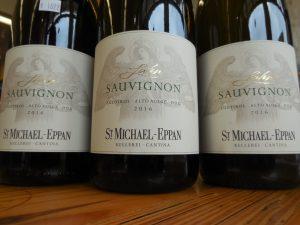
My husband and I opened this wine after a very busy weekend over take out pizza. To make it a bit more festive, after the pizza (potato & bacon and pepperoni & mushroom), we broke out a wonderful nutty aged Robusto Gouda, a nice, perfectly ripe Camembert and a borough-market Stilton with an arugula, blueberry and pine nut salad. This wine stood up to all of it, despite being a cool-climate, relatively delicate white wine. It was tangy enough to balance out the strong flavors of the pizza, yet fragrant and well structured enough to offset the richness of cheeses. It was the perfect end to a hectic, exhausting weekend!
Prost!
Seema
Opening a new bottle of wine is like going on a blind date. Is it worth the time and money? What is it really going to be like? I have an idea about what to expect from the profile – nice label, deep ruby color, French – but what do I really know about this bottle?
Well, put your worries aside, I am the matchmaker you have been searching for! This is the type of wine you have when you come home from a long day, you put on your slippers, grab a nice soft brie or Saint Andre cheese from the frig and collapse on the couch to savor the good things in life. No worries about that blind date going horribly wrong – this wine is totally mellow and easy. You might even ask afterwards, is this too good to be true?
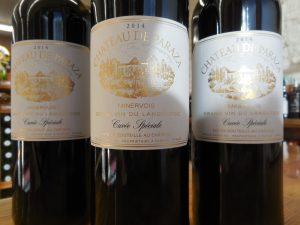
The Chateau de Paraza 2014 Cuvee Speciale is a wine with a long pedigree from one of the warmest parts of France, the Languedoc Wine Region or the more painterly name of Le Midi, where famous artists have flocked for generations. The Chateau de Paraza lands have been planted with grapes and olives since the Roman times. The Chateau itself hosted the civil engineer during the reign of Louis XIV who built the Canal du Midi which links the Atlantic Ocean to the Mediterranean. While it may have run into problems over the last century, it was revived in 2005 as a family-run winery dedicated to high-quality wine that reflects the beauty of the local vineyards.
The wine itself is a brilliant, dark ruby color – with the wonderful spicy and fruity flavors of its blended grapes. 40% Syrah, 40% Grenache and 20% Mourvedre. It has a nose redolent of dark cherries spiced with nutmeg and clove. On the palate, you get a rounded sensation of wild blueberries and black cherries. The tannins are supple, leading to a fresh, fruity finish.
And to top it all off, it is a bargain!
Your wine expert, Seema
We know that Valentine’s Day can be a tad bit stressful. From not knowing if flowers, candy, or champagne are the right gift to knowing if you should plan for a night-in or a night-out, there are a lot of decisions to make. We can’t help you with all the details, but we can help you find a great bottle of champagne or sparkling wine to cheers your loved one to. Check out our recommendations (below) that will impress any valentine out there.
We also have great gift baskets for sale too!
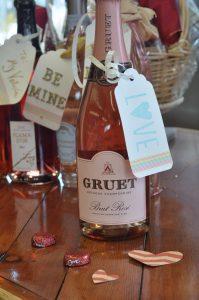
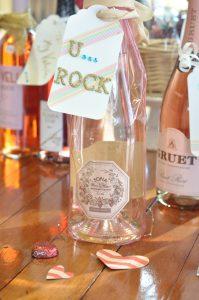
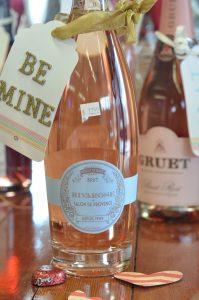
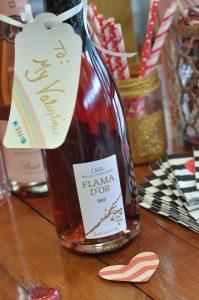
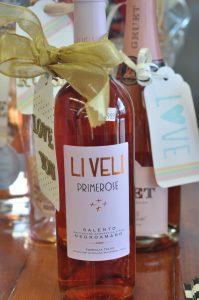
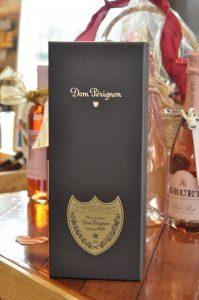
- Gruet Brut Rosé: A beautiful garnet in color, this Rose NV has a delicate, fine mousse and rich, fruit flavors. This full-bodied sparkler starts with floral and berry aromas which introduce flavors of cherry. raspberry and wild strawberry, finishing delicately with zesty acidity.
- Francis Coppola Sofia Blanc de Blancs: Fruity and refreshing, Sofia Blanc de Blancs is a rare blend of Pinot Blanc, Muscat, and Riesling. Mellow flavors of apples and pears are topped by a hint of citrus and honeysuckle. Elegant in character, this wine is lightly textured and vibrant through the finish.
- Royal Provence RivaRose: A gorgeous bottle of Provence rosé with a fine and elegant sparkle. The nose offers up a fresh, soft scent of strawberry, raspberry and a little cherry. The mousse is mouth filling and fine. Flavors of red berries and a little spice. Delicious and refreshing.
- Flama D’Or brut: Fresh and pleasant. Well balanced, good structure and well integrated carbonic elements. Pleasant aftertaste of medium intensity, where the aromas of nose and mouth are repeated harmoniously.
- Li Veli PRIMEROSE: Bright pink with salmon and raspberry reflex; fruity bouquet, with delicate red fruit and flower notes; in the mouth it is balanced, pleasant and full, with a fresh acidity. Fruity aftertaste.
Looking to make Valentine’s Day extra special with a certain little question? Pick-up an extra special bottle to celebrate with –
- Cristal Brut: White peach and acacia blossom aromas accent the flavors of poached apple, gingersnap biscuit, pastry cream and spun honey in this harmonious Champagne. The satinlike mousse caresses the palate, while firm, focusing acidity drives the lasting finish. Drink now through 2030.
- Dom Perignon: Dom Perignon only creates vintage wines; it is an absolute commitment. Only the best grapes of the most exceptional years are used, making each vintage distinct. It is the perfect embodiment of the Power of Creation – an act of creation that elevates the mind and enlightens the world.
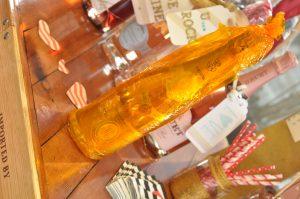
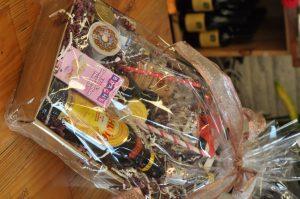
Stop by our Champagne Tasting on Feb. 13th and try a few of these delicious champagnes. Thanks for reading!

